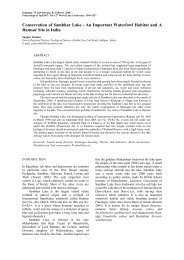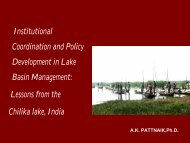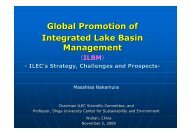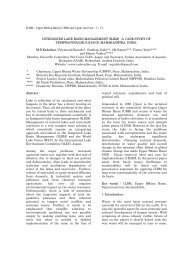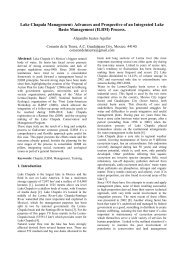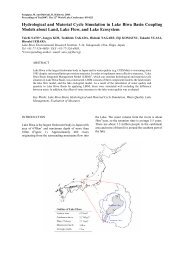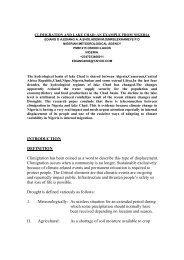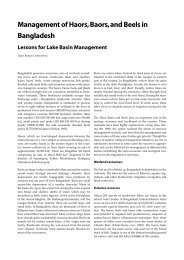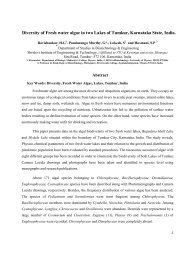Use of endoparasites, Ligula intestinalis plerercoid in ...
Use of endoparasites, Ligula intestinalis plerercoid in ...
Use of endoparasites, Ligula intestinalis plerercoid in ...
Create successful ePaper yourself
Turn your PDF publications into a flip-book with our unique Google optimized e-Paper software.
association <strong>in</strong> monitor<strong>in</strong>g <strong>in</strong>creas<strong>in</strong>g heavy metalpollution <strong>in</strong> lacuster<strong>in</strong>e environment. This hostparasiteassemblage was analyzed at different sites toidentify the variable metal exposure <strong>in</strong> the coastalzone <strong>of</strong> Lake Victoria.2. Materials and methods2.1 Study area and sampl<strong>in</strong>g sitesLake Victoria, the second largest freshwater body<strong>in</strong> the world (area 68,800 km 2 ), is generally shallow(mean depth 40 m) and lies <strong>in</strong> a catchment <strong>of</strong> about184,000 km 2 , shared by three riparian states (Kenya,Tanzania and Uganda). Site selection <strong>in</strong> Kenya wasbased on the anthropogenic activity pr<strong>of</strong>iles along thecoastal zones (Fig. 1). Site 1 (Kisumu City) has apopulation <strong>of</strong> about 1.1 Million and is a centre <strong>of</strong>urban development with various <strong>in</strong>dustries anddra<strong>in</strong>age <strong>of</strong> <strong>in</strong>tense agriculture. Site 2 (Kendu-Bay) isa rural agricultural area without fertilizer <strong>in</strong>puts. Site 3(Karungu) receives dra<strong>in</strong>age from small gold m<strong>in</strong>es.Site 4 (Port Victoria) is a rural area, receiv<strong>in</strong>g waterfrom the River Nzoia, conta<strong>in</strong><strong>in</strong>g effluents from twosugar factories and a paper mill factory situated about100-150 km upstream from the Lake.L. <strong><strong>in</strong>test<strong>in</strong>alis</strong> <strong>in</strong>volves three hosts, a crustacean(copepod), a fish (e.g. R. argentea) and a bird (e.g.pied K<strong>in</strong>gfisher or Cormorant). Copepods carry<strong>in</strong>fective stages <strong>of</strong> the parasite, which are transferredto the fish R. argentea and subsequently to the fishconsumers <strong>in</strong> the coastal zone <strong>of</strong> the Lake Victoria.Accumulated metals are thus transferred via the samefood cha<strong>in</strong>.Fish samples were obta<strong>in</strong>ed from local fishermenon two sampl<strong>in</strong>g occasions <strong>in</strong> June 2006 from the sitesS1, S2, S3 and S4 us<strong>in</strong>g a beam trawl with 5 mmstretched mesh; fish was attracted <strong>in</strong> the night bylamps. The catch data are presented <strong>in</strong> Table 1. Tom<strong>in</strong>imize contam<strong>in</strong>ation, all materials used <strong>in</strong> theexperiment were previously washed <strong>in</strong> ultra purewater. Fish were weighed (to the nearest 0.1 g),measured (folk length <strong>in</strong> mm) and dissected.Dissection <strong>of</strong> the fish was done on the shore us<strong>in</strong>gsta<strong>in</strong>less steel <strong>in</strong>strument pre-cleaned <strong>in</strong> doubledistilled water. In parasitized fish, parasites wereremoved us<strong>in</strong>g sta<strong>in</strong>less steal <strong>in</strong>struments, counted,weighed and stored <strong>in</strong> glass vials and later transferredto Teflon vials and freeze dried, await<strong>in</strong>g furtheranalysis. Both parasitized and unparasitized fish werebagged and frozen until processed <strong>in</strong> the laboratoryus<strong>in</strong>g metal-free techniques <strong>in</strong> the Netherlands.2.3 Metal enrichmentsWater from Lake Victoria was enriched us<strong>in</strong>g Pb,Cd, Cr and Cu. The concentration <strong>of</strong> the specific metalapplied were 10 times the <strong>in</strong>itial concentration <strong>of</strong> theLake water <strong>in</strong> site 1. The parasitized and nonparasitized fish were then transferred to the water andleft <strong>in</strong> the solution for 96 h.Fig. 1. Map <strong>of</strong> Lake Victoria bas<strong>in</strong> (Kenya) show<strong>in</strong>g thesampl<strong>in</strong>g sites2.2 Fish and endoparasite collectionThe fish host chosen <strong>in</strong> this study was a cypr<strong>in</strong>id, R.argentea (Pellegr<strong>in</strong>, 1904). This fish occurs <strong>in</strong> a highabundance <strong>in</strong> Lake Victoria, more than any otherspecies. Dur<strong>in</strong>g the past eight years it has composedbetween 37 – 45% <strong>of</strong> the commercial fish catch(Wan<strong>in</strong>k, 1999). Due to its relatively low price, itdom<strong>in</strong>ates as a source <strong>of</strong> prote<strong>in</strong> among the poor lakeshore communities, ma<strong>in</strong>ly because other larger fishspecies are preferred for trade, <strong>in</strong>clud<strong>in</strong>g export for thecountry’s foreign exchange earn<strong>in</strong>g. The life cycle <strong>of</strong>2.4 Metal analysisThe frozen samples were thawed, crushed andhomogenized us<strong>in</strong>g a Fritsch, Pulverisette 5, planetarymill (Fritsch GmbH Laborgerate, Idar-Oberste<strong>in</strong>,Germany) for 5 m<strong>in</strong>utes at 400 rpm. About 0.5 g <strong>of</strong>sample were accurately weighed <strong>in</strong> Telflon (© polytetra-fluor-etheen(PTFE), DuPont) high pressurevessels. Then 4.0 ml concentrated nitric acid (65%),1.0 ml concentrated hydrochloric acid (37%) and 1.0ml ultra pure water was added to the samples. Sixsamples were placed <strong>in</strong> the carousel <strong>of</strong> a PaarMicrowave oven (Anton Paar GmbH – Graz –Austria).Digestion took place at 200°C and 70 bar pressuredur<strong>in</strong>g 15 m<strong>in</strong>utes. After cool<strong>in</strong>g the obta<strong>in</strong>ed clearsolutions were quantitatively poured <strong>in</strong> 50mlvolumetric flasks and diluted to the mark with ultrapure dem<strong>in</strong>eralized water. F<strong>in</strong>ally the diluted solutionswere transferred <strong>in</strong>to acid cleaned polyethylene bottles.All elements were determ<strong>in</strong>ed by means <strong>of</strong> <strong>in</strong>ductivelycoupled plasma-optical emission spectrometry (Perk<strong>in</strong>Elmer Optima 3000 XL, ICP-OES) us<strong>in</strong>g the PEcalibration standards. The concentrations werecalculated as mg kg -1 dry weight. The quality <strong>of</strong> theanalytical process was controlled by the analysis <strong>of</strong>IAEA MA-A-3/TM certified standard referencematerial <strong>of</strong> shrimp. Measured values deviated lessthan 10% from the certified values.2




